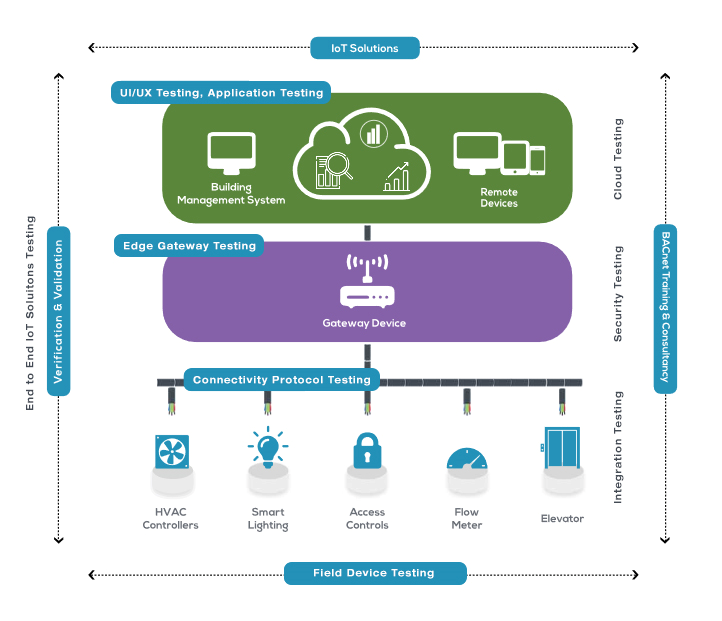B-AACC
| Data Sharing |
|
| Alarm & Event Management |
|
| Scheduling |
|
| Device & Network Management |
|
Smart building OEMs must rapidly innovate and develop energy efficient, safe and secure building management solutions and components. These technology solutions are used globally to transform traditional buildings into smart offices, smart airports, smart retail and smart homes.
To be competitive, building automation OEMs need to engineer products and systems that comply with complex, ever-evolving building controls engineering standards. PTL is perfectly positioned to verify and validate these complex solutions and help OEMs achieve faster time to market with robust products and solutions.
PTL plays the role of the first critical customer to validate such complex systems helping OEMs to bring bug free, fully tested and stable products and solutions to market.


Traditional building automation systems comprising of HVAC, fire alarm, lighting, access door, elevators, energy measurement, surveillance enable multiple complex use cases to build data centric intelligence within building management solutions. These solutions need to be thoroughly verified and validated before they get deployed in the field.
This situation demands that an independent third party like PTL must be engaged in the product/solution development life cycle, validating and testing end-to-end complex building IoT applications to help customers deliver robust solutions.
Smart building networks are dominated by various choices of communication protocols – OEMs must to choose to build proprietary or open standards embedding wired and/or wireless connectivity protocols like BACnet, Modbus, KNX, LonWorks, Zigbee, Z-Wave and OPC UA. In addition, the IoT revolution demands embedding internet protocols like Haystack, MQTT, CoAP on the north bound side where the data is exposed to the cloud over the internet. PTL is a pioneer in providing testing solutions across all such communication protocols.


Product managers must build feature plans and create product requirement documents which form the basis for product development. Despite following good processes during a typical product life cycle, many products fail in the field, increasing the cost of maintenance with a risk of diminishing the OEMs brand value and market reputation. To minimize such risks, OEMs must engage an independent third party to validate and test their products and solutions.
PTL with its deep domain expertise examines product plans and documents which development teams may overlook eventually causing failures in the field.
There is an increasing trend in the smart buildings segment to host BMS systems over the cloud enabling monitoring and control of multiple connected buildings from a single location. This causes several challenges for solution providers to meet stringent performance requirements. In case of standalone products like building controllers and application specific controllers, communicating over various fieldbus protocols becomes a challenge to meet performance requirements even though product functionalities may be working properly.
PTL’s deep domain knowledge and ability to form a simulated environment to validate performance along with its expertise in test automation, creates a compelling option for OEMs to successfully manage product/solution performance challenges.


Traditional building management systems were mainly limited to HVAC systems but today they are fully integrated with lighting systems, elevator systems, access control systems, fire alarm & safety systems, parking systems, camera-based surveillance systems, weather monitoring systems and facility management systems.
Such independent systems are integrated with each other using application programming interfaces (API’s) which must meet expectations with respect to functionality, performance, reliability and security of the overall system.
PTL’s rich experience in working with such smart and complex IoT enabled solutions using advanced technologies, helps OEMs to arrest defects and drawbacks while deploying APIs in the integrated environment.
Today’s building management systems demand solutions comprising of various software components all developed through a partner eco system and to be integrated to form the wider solution.
Smart building deployments must deal with integration of many third-party systems calling for OEMs to work together. This kind of integrated environment demands an efficient effort in the form of integration testing.
PTL can act as the third eye to make smart building solutions reliable, robust and flawless.


Smart building solutions comprise of cloud, middleware, client-server and embedded software applications, all leading to varied use cases. Before deployment, solution providers must deal with the challenges of building a skilled and knowledgeable in-house workforce to carry out testing during the development life cycle as well as during the final black box testing.
PTL’s rich experience and domain knowledge helps OEM’s with verification and validation of software applications to achieve faster time to market with a robust solution.
BMS applications used for controlling and monitoring various systems needs to be easy to use and provide an excellent user experience.
From a business perspective, great UI/UX has become one of the most important aspects of any product’s success in the market. However, testing such applications to ensure that expected levels of UI/UX is a growing challenge for OEMs.
PTL’s deep domain expertise in the smart buildings domain and UI/UX testing experience helps customers build a world class UI/UX capability.


Traditional on-premise BMS applications are transitioning to be hosted on cloud service providers (AWS, Azure or private cloud), enabling remote monitoring and control of connected buildings. Building data from various systems like HVAC, lighting, elevators, fire alarm systems etc is aggregated through gateways and passed on to the cloud through various IoT and middleware platforms and multiple systems are involved to achieve the expected outcome. OEMs struggle to test and validate these complex and integrated cloud solutions.
PTL, through its deep domain knowledge, IoT technology expertise and skilled cloud technology professionals offers a one-stop-solution for validating and testing cloud-based solutions using advanced methodologies and techniques.
Cloud based smart building solutions need a secure gateway to communicate data and information from building networks to cloud networks over the internet. This need is driving the growth of client-side gateway product lines which have the capability to communicate data from standard south bound protocols like BACnet, KNX, Modbus to north bound protocols over the internet like Haystack, MQTT, CoAP etc.
Edge gateways are rapidly gaining market share with high compute powered intelligent applications like in-built data analytics, rule engines, control algorithms. Edge gateways have the provision for seamless integration with 3rd party systems.
PTL has in-depth strength and experience in testing various complex multiprotocol gateway applications including data security and data analytics. OEMs can leverage PTL’s capabilities to shorten time to market and detect product failures before they hit the market.


The evolution of mobile and IoT technologies are complimenting each other. In the smart building sector, smart BMS applications are hosted on the cloud providing easy user access from anywhere using mobile applications thus enabling more end user centric use cases.
There is a growing need to test such mobile applications using native or hybrid platforms. PTL is well equipped with multiple testing solutions for mobile applications.
Building management systems rely on intelligent algorithms to increase the overall energy efficiency, comfort, safety and security for human beings. The data gathered from various sources is analysed using machine learning and deep learning applications. This data is stored in different databases like MongoDB, InfluxDB etc and is further processed for analysis to allow for controlling actions. This brings challenges to solution providers and OEMs in terms of validating such intelligent systems.
PTL’s smart building domain experts, data scientists and machine learning experts carry out verification and validation of such systems and help OEMs and solution providers improve time to market with stable bug free products.


Smart building management solutions comprise of cloud-based management systems, on premise management systems, building controllers, application specific controllers, sensors and actuators. All these systems are categorized either software systems or embedded systems. Stringent performance testing, load testing, stress testing and regression testing must be carried out on these systems before field deployment. Automated testing using scripting language like python or selenium like tools becomes important to achieve time to market and cost optimization.
PTL’s smart building domain experts make use of test automation frameworks like softTAF and other available frameworks and tools to build automated testing environment to help OEMs achieve their business goals.
| Data Sharing |
|
| Alarm & Event Management |
|
| Scheduling |
|
| Device & Network Management |
|
| Data Sharing |
|
| Alarm & Event Management |
|
| Scheduling |
|
| Device & Network Management |
|
| Data Sharing |
|
| Alarm & Event Management |
|
| Scheduling |
|
| Trending |
|
| Device & Network Management |
|
| Data Sharing |
|
| Alarm & Event Management |
|
| Scheduling |
|
| Trending |
|
| Device & Network Management |
|
| Data Sharing |
|
| Alarm & Event Management |
|
| Scheduling |
|
| Trending |
|
| Device & Network Management |
|